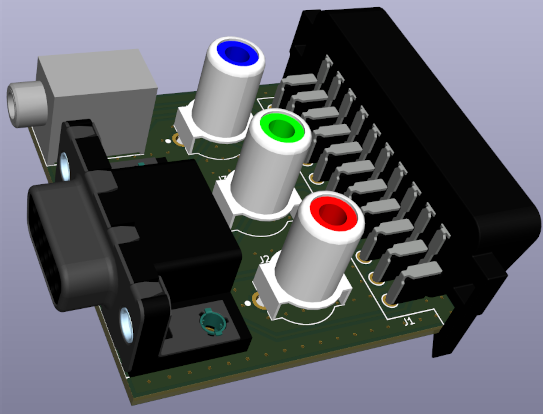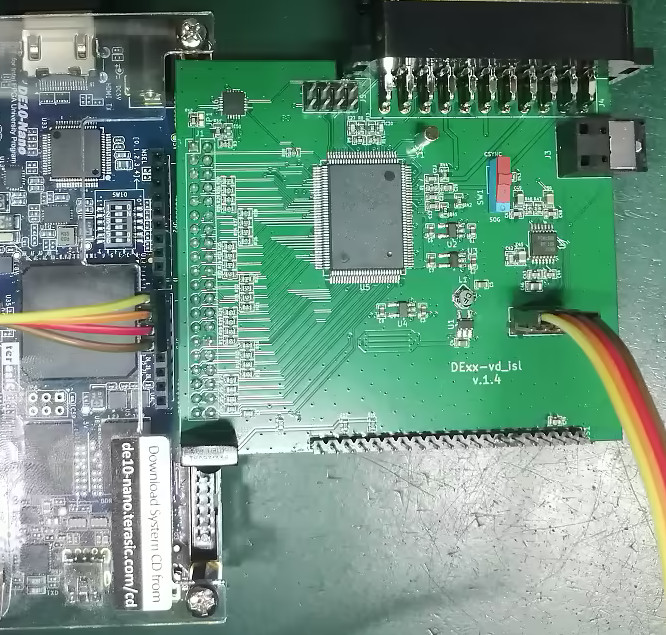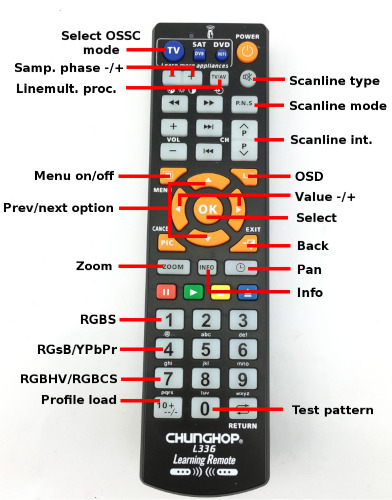DExx-vd isl
Contents
Introduction
DExx-vd_isl is video digitizer expansion card for selected Altera/Intel FPGA development boards, primarily DE10-Nano. Most common use scenario is connecting retro video game consoles and home computers to modern displays. The combination of FPGA development board and expansion card has been used in development of OSSC Pro and can be considered OSSC Pro Lite version since aside from more limited connectivity and performance, it shares most major features.
If you're new to the OSSC and scalers/processors in general, you may wish to jump to the quick start guide.
Features
- Digitizes analog video sources in RGBS, RGBCS (TTL csync), RGBHV and YPbPr formats connected to SCART connector
- Up to ~110MHz sampling clock supporting up to 720p@60/1080i@60 inputs.
- Output up to ~165MHz (1920x1080p@60, 1920x1200p@60 etc.)
- Analog and digital audio inputs via SCART and toslink (DE10-Nano needs a modification for SPDIF support)
- OSD and optional character display as UI. (compatible LCDs are Newhaven NHD-0216CW & NHD-0220CW)
- IR control using OSSC remote control.
- Line multiplication and scaler operating modes
- Free running and frame locked operation
- Motion adaptive deinterlacing
- Low latency (<=40 scanlines in LM mode, ~1 frame in framelocked scaler mode)
- Various sampling presets for classic consoles and home computers
- Postprocessing options including scanlines and BFI
Board versions and availability
DIY
PCB and parts for the board can be purchased from known manufacturers (e.g. JLCPCB, OSHPark) and suppliers (e.g. Mouser, Digikey) but at the time of writing it may not be feasible/economical due to component shortages.
Pre-assembled board
Pre-assembled boards are sold worldwide by:
More information & discussion
AV inputs
AV1 (SCART)
The SCART connector of DExx-vd_isl supports a number of video/sync formats. SCART-RGB sources can be connected as-is while other formats require passthru cables/adapters. Input is selected via remote key / OSD input menu and the on-board sync switch. The table below summarizes available inputs, their corresponding remote hotkeys and required position of the sync switch.
| Input name | Remote hotkey | Sync switch position | Notes |
|---|---|---|---|
| Test pattern | 0 | Any | Change test resolution with LEFT/RIGHT remote keys or via menu. |
| AV1_RGBS | 1 | CSYNC | For video level c-sync only. Sync can be also extracted from composite video / luma. |
| AV1_RGsB | 4 | SOG | Use suitable adapter / SCART cable. |
| AV1_YPbPr | 4 (tap twice) | SOG | Use YPbPr to SCART passthru adapter. Some suitable adapters are sold online (e.g. this) but most don't include audio jacks. |
| AV1_RGBHV | 7 | Any | Needs a custom adapter/cable which routes HSYNC to SCART pin 12 and VSYNC to pin 10. |
| AV1_RGBCS | 7 (tap twice) | Any | For TTL c-sync only. Needs a custom adapter/cable which routes CSYNC to SCART pin 12. |
AV input adapter
A custom adapter (shown below) can be used to connect VGA or component input sources. A fully wired SCART cable needs to be connected between the adapter and DExx-vd_isl board. Design and gerbers are available here. DIY kit for the adapter may be released later.
Toslink
The toslink input supports LPCM 44.1/48/96kHz and compressed bitstream (Dolby Digital, DTS) formats. The audio stream is forwarded as-is to HDMI transmitter.
Basic setup & usage
Board installation
DE10-Nano
Insert the board into the GPIO header which is closer to the FPGA so that both HDMI and SCART ports are facing the same direction and plug the 4-pin jumper cable between the boards as shown in the picture. For those who'd like to install the board on the other side, see this thread. If you use standard SCART-RGB sources, flip the red sync switch towards "CSYNC" as pictured.
Prepara a dedicated microSD card (>=64MB) by downloading and unzipping latest firmware image and writing it on the card in raw e.g. via Win32 Disk Imager. Subsequent firmware updates can be made by easier fashion, see #Firmware update.
Additional notes (e.g. how to enable SPDIF) are found on the board-specific README.
For anyone experiencing stability issues in scaler mode with v1.4 board, this thread details a suggested fix.
Other development boards
- C5G
- DE2-115
Remote control
DExx-vd_isl operates with L336 infrared remote pre-programmed for OSSC. Key functionality is listed below.
- 0-9: Selects AV source and input format. See remote picture on the side for reference.
- MENU: Activates/deactivates OSD menu
- OK: Selects sub-menu or function
- BACK: Returns to previous menu level or from info page to normal source display page
- UP/DOWN: Selects next/previous menu option or next/previous input when not in menu.
- LEFT/RIGHT: Option value -/+
- INFO: Displays detailed timings of video input and output. Also displays firmware version.
- SCANLINE_MODE: Hotkey for selecting next "Scanlines" option value
- SCANLINE_TYPE: Hotkey for selecting next "Scanline type" option value
- SCANLINE_INT+/-: Hotkeys for adjusting scanline strength
- LINEMULT_PROC:
- SAMP_PHASE+/-: Hotkeys for sample phase adjustment
- ZOOM:
- PAN:
- OSD: Toggles between different OSD modes
- PROFILE_LOAD: Opens quick menu for loading profiles
Getting started
Once DExx-vd_isl has been attached to the development board and source and monitor are connected, power on the development board. A 480p test pattern should show up in the monitor. Turn on the video source and select correct input via remote and sync switch (refer to #AV1 (SCART) table).
The firmware has 2 primary operating modes: line multiplier and scaler. Line multiplier is reminiscent of classic line doublers and OSSC while scaler works more like video processors like VP50 or Framemeister. In general scaler mode offers more flexibility and easier usage via fixed output resolution and (optionally) fixed refresh rate. Some users may prefer to stay with strict multiplication to preserve the original look as much as possible, though. The mode can be switched from "Output opt -> Operating mode" on the menu. Main menu has matching sub-menus for each of the 2 operating modes which are accessible even if the said operating mode is not active. Most important picture processing settings are found under these sub-menus, refer to next section for mode details.
Settings
Refer to OSSC_Pro#Settings
The following settings are not available DExx-vd_isl:
- Inputs other than AV1
- Analog sync pre-STC
- AV4 video in opt.
- 1080p120 preset
- 2160p60 preset
- Extra AV out
- Pre-ADC gain
- AV2-4 audio source
- 3.5mm jack assign
- Fan PWM
- Led PWM
- Load profile (DE10-Nano has only SD load option available)
- Save profile (DE10-Nano has only SD save option available)
- Fw. update
The following setting values have limited functionality with DExx-vd_isl:
- 2x Hz/100Hz/120Hz modes (limited to 720p)
- 1440p output mode may not be stable on DE10-Nano
- 2880x2160 modes are not functional
Firmware update
DE10-Nano
Check the existing firmware version by pressing INFO key on remote:
- v0.58 or earlier: Write the firmware image on SD card as described in DExx-vd_isl#DE10-Nano
- v0.59 or later: Eject the SD card and insert in into a computer. Replace DE10-Nano-vd_isl.rbf file on the filesystem with latest version.
Other boards
Program latest .jic file on the flash of the development board. Refer to board-specific READMEs in github for more details.
Firmware changelog and roadmap
v0.73
- aligned with OSSC Pro firmware v0.73
Older versions
v0.67
- added Reverse LPF option
- added Hybrid scanlines option
v0.66
- added X68k presets
- fixed various P-LM issues
v0.64
- added interlacing support for A-LM (480p->480i, 576p->576i, 1080p->1080i)
- fixed A-LM Generic 16:9 for 2560x1440
- added some A-LM output presets for 576i/p inputs
- fixed some issues related to downscaling
- fixed SCL 576i mode mappings
- optimized scanconverter pipeline performance
v0.62
- added Auto aspect ratio option
- added 480i & 576i CRT modes and moved CRT output modes under dedicated option
v0.61
- added 240p/288p/480p/540p CRT output modes and 1920x1080i mode
- fixed Pure LM processing for 256col modes
- fixed some aspect ratio calculations
- added auto mode for YPbPr source colorspace
- fixed manual phase adjustment for oversampled modes
v0.59
- added support for profiles on SD card
v0.57
- Initial release


